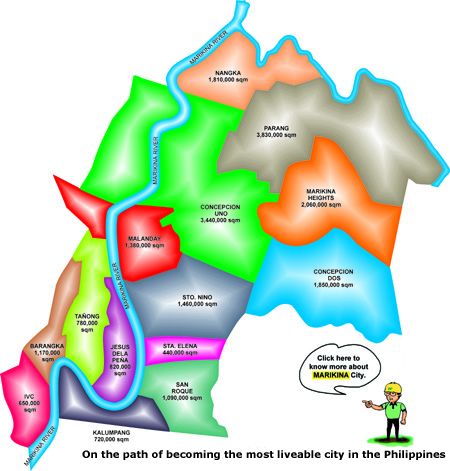|
|||||||||||
| History Local Government Unit Barangay |
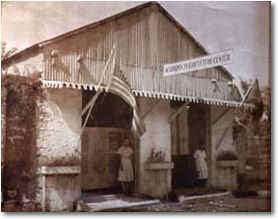 |
HISTORY
|
Just like Pasig River whose fertile soil attracted the natives who converted the area into rich farmlands prior the arrival of the Spaniards, the Marikina riverbanks had also long been settled by river-dwellers or taga-ilog. They were the natives whom the Augustinian friars referred to when they explored the areas along the Marikina riverbanks in 1570s and discovered a cluster of huts around a manantial (later called Chorillo and today as Barangka). In its immediate vicinity, the priests built a visita which served as their center for taking care of the spiritual needs of the settlers. On April 16, 1630, Fray Pedro de Arce, apostolic ruler of the Archbishop of Manila, approved the transfer of ecclesiastical control and supervision of Marikina area to the Jesuits. The Jesuits established a mission in a place they called Jesus dela Peņa (Jesus of the Rocks) on the west bank of the river. They also invited several Chinese traders and agriculturists to join hands with the natives in launching an hacienda. Two of the first Chinese mestizo families who settled in the poblacion were surnamed "dela Paz" and "de los Santos." The place was beautifully developed and, after a century, the entire hacienda was officially named by the Jesuits in honor of San Isidro Labrador, the patron of the families. The story of how the town got its name "Marikina" is largely based on legends. According to one source, it was Trinidad H. Pardo de Tavera who said the town was named after Captain Berenguer de Marquina who was once a chief executive of the town before Marikina was declared a pueblo in 1787. Another legend has it that the town was named after a priest who was given the instruction to baptize the natives following the establishment of the Jesuit mission. Another source said that the Jesuits named the town after their hometown in Spain, a town along the Charmaga River called Mariquina. Still another story tells of a rich, beautiful and kind woman, Maria Quina, whose fame had spread to a wide area. Then there is the story of a worker telling a priest that the church that was being built at the center of the town was "Marikit-na" (beautiful now.) |
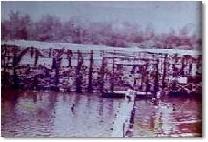 |
The name "mariquina" lasted for decades until Pardo de Tavera, early in the years under the US- Philippines Commission, suggested that name be changed to its present name of Marikina. Marianna's history cannot be complete without considering the Tuason clan. A daughter of one of the influential families of Marikina named Doņa Teresa de la Paz y de los Santos was married to Don Jose Severo Tuason, the fourth lord of the Hacienda de Mariquina considered to be the biggest private hacienda in the country. |
The Tuasons had emerged as the leading Chinese mestizo family not only in their original place. Binondo, but in the entire colony. The patriarch of the clan, Don Antonio Tuason, made his fortune in the Galleon Trade and was possibly the richest man in the Philippines by the second half of the 18th century. His family ascended the Spanish nobility by a royal decree in 1782 and was exempted from paying tributes for two generations in 1775 as a reward for his loyalty and boundless generosity. To express his gratitude to the King of Spain, Carlos IV, Don Antonio founded a mayorazgo (noble estate) on Feb. 25, 1794, which was approved in the King's decree of August 20, 1795. The Mayorazgo Tuason appeared to be the only noble estate in the Philippines. The successors to the mayorazgo was based on male primogeniture (first born or eldest son). This was not only a Spanish policy but also a Chinese custom. In fact, Son-tua, the original surname of the Tuasons, means "eldest son." The first holder of the mayorazgo was Don Vicente Dolores Tuason. |
The Society of Jesus was expelled from the Philippines in 1768 and all its properties were seized by the crown. Don Vicente acquired the Jesuits' Hacienda de San Isidro de Mariquina at a public auction in 1794. He paid a total of 33,750 pesos for the said property. Don Vicente's grandson, Jose Severo, first-born son of the third lord of Mariquina, Don Jose Maria Tuason and Doņa Maria Josefa Patino y Tuason, married in defiance of familial expectations, Teresa de la Paz. This lady who was called by Jose Severo as "Mariquit na Teresa" when she was being wooed by him, and later on, "marqueza" when she took possession of the Hacienda Mariquina, as well as that of Sta. Mesa (part of the huge property of the Tuasons) in October 1, 1878. |
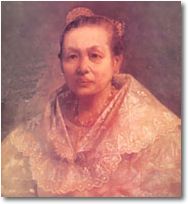 |
Marikina officially became a town in 1787. That same year, it elected its first gobernadorcillo, Don Benito Mendoza. Thirty-four other men succeeded him in that post until 1821. Another long line of 75 town executives called alcalde or capitan were elected until the outbreak of the revolution in 1896. During the revolution, the local government system was disrupted. But after the proclamation of the Philippine Independence on June 12, 1898 in Kawit, Cavite, President Emilio Aguinaldo attempted to reorganized the local government. Marikina and other towns comprising the Province of Morong and Manila has signed the act of Independence. Aguinaldo proceeded to appoint provincial officials. Don Ambrosio Flores, appointed governor of Manila province, chose Marikina as capital. |
 |
Following the fall of the Philippine government during the Filipino-American war, the Americans established a military government and started a campaign of pacification. Later, they started appointing town executives called presidente. Vicente Gomez or Tenten was appointed presidente of Marikina in 1900 charged with the restoration of civil order. He convinced the people to return peacefully to their homes and to swear allegiance to the United States. There were some holdouts including two avid followers of Gen. Artemio Ricardo, alias "Vibora," the last revolutionary general to surrender to the Americans. Among the holdouts were Francisco Sanchez, Julian Santos, Gen. Hermogenes Bautista and Julian Cruz. But after sometime, many of the holdouts were convinced to cooperate with the American authorities. |
A new province out of the Morong District named Rizal was created on June 11, 1901 with Pasig as capital and Marikina as one of its towns. Gen. Ambrosio Flores was appointed governor, while Vicente Gomez, Sr., was appointed presidente of Marikina and served from 1902-1903. He was succeeded in this post by 11 other men, some elected under the Commonwealth regime until the Japanese invasion in 1941. Many Marikeņos occupied positions in the provincial and national government before and after World War II. Catalino Cruz, known as "Imong Bokal," was a member of the provincial board from 1920-23. Nicanor Roxas also served as member of the board from 1925-28, and as provincial governor during the Japanese occupation. In 1934, a staunch supporter of Commonwealth President Manuel L. Quezon and apillar of the local Nacionalista Party, Emilio de la Paz was elected representative of the second district of Rizal to the first national assembly. He was reelected in 1938 and was returned to the postwar House of Representatives in 1949. Emilio was the brother of Wenceslao de la Paz who served as town presidente from 1929 to 1937. He was also the father of Emelito de la Paz who was elected assemblyman to the Batasang Pambansa in 1984. Serafin Salvador was elected to the seat of Emilio de la Paz from 1954-57. He later served in the cabinet of President Carlos P. Garcia. |
Elected presidente in 1938, it fell upon Dr. Juan Chanyungco to deal with the Japanese occupation forces. He stayed as town executive until 1944 when the Japanese found out his links with the guerilla government. He was arrested by the Japanese authorities but escaped while he was being brought to Montalban (now Rodriguez). With the restoration of civil government under Pres. Sergio Osmeņa, rehabilitation of the town started under Enrique de la Paz who was appointed mayor in 1945. He was a nephew of Congressman Emilio de la Paz. |
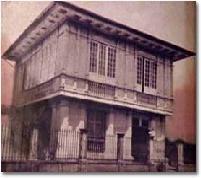 |
With the election of Pres. Manuel A. Roxas in 1946, he appointed Gil Fernando, a pillar of the local Liberal Party, as mayor of Marikina. Fernando was elected mayor on his own in the first postwar local elections in 1947 and served until 1951. He was again elected mayor from 1956 to 1959. Dr. Juan Chanyungco made a comeback in 1951 to 1955. Osmundo de Guzman succeeded Gil Fernando in 1960 and remained mayor until his death in February 1986, a few days before the outbreak of the EDSA Revolution. His 26 years in office were the longest for any town mayor. His term included the martial law years which began in 1972. There was no local election from 1975 to 1980. In June 1975 the Metro Manila Commission was created under Presidential Decree No. 824 integrating four cities and 13 towns, majority of which were in the Province of Rizal. |
Marikina then became part of the Metropolitan Manila area. Vice Mayor Teofisto Santos served as town executive for a little more than a month until he was ousted by the revolutionary government under President Corazon C. Aquino. Rodolfo Valentino, a dentist by profession and a scion of a shoemaking family, was appointed Officer-in-Charge until 1988 when he was elected mayor on his own. He remained mayor until June 30, 1992 when he lost his reelection bid against Bayani "BF" Fernando. Mayor Fernando was reelected in 1995 and again in 1998. HOw Marikina Became a City Mayor Bayani F. Fernando took office in 1992 determined to see Marikina become a city during his watch. It could have been a city in 1994 when it qualified, but no initiative was taken in the House of Representatives. It needed the help of Speaker de Venecia and Congressman Carmencita O. Reyes, whose ancestors hailed from Marikina, to get a bill moving in the Lower House. As promised by the Speaker, the bill was passed by the House of Representatives on second reading in December 1995, after a public hearing was held in Marikina. The Senate approved the bill unanimously on September 30, 1996. Explaining his vote, Senate President Neptali Gonzales cited the rapid progress of Marikina under Mayor Fernando whose father, Mayor Gil Fernando, was a partymate of Gonzales in the Liberal party for many years. The stage was set for the signing of the bill into law by President Fidel Ramos on November 6,1996 at Malacaņang. Some 150 Marikeņos, among many guests, heard the President hailed Republic Act 8223 as a “recognition of the indefatigable efforts of the people of Marikina towards development led by Mayor Bayani F. Fernando”. The next step was to ratify the law in a plebiscite to be held within 60 days from its approval, the deadline for this exercise falling on January 6, 1997. Mayor Fernando requested the Commission on Elections to set an early plebiscite. He wanted it before December 15,1996 or it would have to wait for another year to get a bigger Internal Revenue Allotment (IRA) of P180 million, against P70 million. |
On December 6, 1996, Marikina became a city when Republic Act 8223 was signed by President Fidel V. Ramos and subsequently ratified by the people through a plebiscite converting the same into a highly urbanized city. The ascension of Marikina into a city was considered an offshoot of four years of hard toil leading to the town’s dramatic transformation under the leadership of Mayor Bayani F. Fernando. On March 13, 1997, Marikina, formally inaugurated a city and , thereby, attained a milestone in its long and colorful history. |
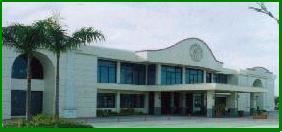 City Hall Mission & Vision Officials |
VISION
Marikina: A community whose people experience the integrity and ownership
of change and development in partnership with the local government
with the end in view of building good neighborhoods that make happy families.
Marikina chose Singapore to be its benchmark for a number of reasons
foremost of which are its familiar attributes of discipline, self-sufficiency,
effective governance, work ethics, environmental soundness, economic dynamism
and corrupt-free government.
MISSION
In line with this vision, Marikina is pursuing its physical development
which takes into consideration essential elements such as Ensuring good access between
and among different areas of the city, defining spaces, making memorable spaces
and using the city's physical setting to its best advantage.
LOCAL ELECTED OFFICIALS
DEL R. DE GUZMAN
Congressman
MA. LOURDES C. FERNANDO
City Mayor
MARION S. ANDRES
City Vice-Mayor
CITY COUNCILORS
Coun. Jose Fabian Cadiz
Coun. Donn Favis
Coun. Lea Carlos
Coun. Larry Punzalan
Coun. Eva Aguirre-Paz
Coun. Tito Ortiz
Coun. Thaddeus Antonio Santos, Jr.
Coun. Boyet Ezpeleta
Coun. Ferdie Marco
Coun. Efren de Guzman
Coun. Jaime Tiburcio
Coun. Lea Astrud Santiago
Coun. Serafin Bernardino
(ABC President)
Coun. Joselito del Prado
(SK Federation Chairman)
|
Kap. Serafin Bernardino - Taņong Kap. Benjamin Cruz - San Roque Kap. Mario de Leon - Kalumpang Kap. Celso Mendoza, Jr. - Sta. Elena Kap. Ramoncito Francisco - Jesus dela Peņa Kap. Pablito Antonio - Sto. Niņo Kap. Frankie Ayuzon - Barangka Kap. Dominador Velasquez, Jr. - Industrial Valley Complex Kap. Ricardo Felipe - Malanday Kap. Rudy Francisco - Concepcion Uno Kap. Armando Llado - Concepcion Dos Kap. Raul Taytayan - Marikina Heights Kap. Vivian Rebecca Favis - Parang Kap. Mairugin Santos - Nangka |
Melvin Cruz - City Administrator Marcelino Teodoro - Management Consultant Adrian Salvador - Chief, Executive Assistant Tomas Aguilar, Jr. - City Planning and Development Officer Zenaida Santos - City Budget Officer Alfonso Espiritu - City Engineer Nancy Teylan - City Legal Officer Ricardo Castro - City Treasurer Santiago Ramos - City Assessor Alberto Herrera - City Health Officer Lolita de Leon - City Council Secretary Julie Borje - Training Director, Center for Excellence Liwayway Cahanap - City Accountant Janet Obispo - City Personnel Officer Evelyn Nabus - City Librarian Roberto Ponce - Chief, Marikina Settlements Office Mario Villanueva - Chief, City Tourism Office Jose Pinga - City Parks Administrator John Torres - City Procurement Officer Carmelita Lorenzo - City Trade and Industry Officer/Chief, Public Information Office Teodora Coronado - City Civil Registrar Gloria Buenaventura - Chief, Waste Management Office Apolonio Santos - Chief, Business Permits & Licensing Office Warren Sira - OIC, Community Relations Office Eddie Mojar - Chief, General Services Office Jaime Perez - Chief, Demolition Office Ricardo Carlos (Ret) - Chief, Office of Public Safety & Security Coun. Dondie Agapito - Chief, Marikina Sports Center Natividad Cabalquinto - OIC, Cultural Office Domingo dela Paz - Chief, Rescue 161 Rene Nepomuceno - City Market Administrator Salome Aquino - Chief, Building & Grounds Maintenance Office Nicasio Cruz, Jr. - Chief, Marikina Land Transportation Office Noel Perez - Chief, City Pound Office Gildegardo Munar - Chief, Workers Affairs Office Public Employment Service Officer (PESO) Rommel Felipe - Chief, Repair and Maintenance Office Crescencia Reyes - Chief, Department of Social Welfare & Development Cipriano Erfe Querol Jr., Al-haj - Chief, Marikina Police Station Commander Domingo Alzaga - Chief, Traffic Management Unit, Marikina PNP Edgardo Gonzales - Chief, Marikina Fire Station Commander Linda Mingoa - Jail Warden, BJMP Marikina |

